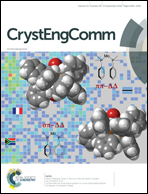Anisotropic temperature–electric field phase diagrams and domain structure evolution in rhombohedral Mn-doped PIN–PMN–PT single crystals†
Abstract
Domain pattern evolution driven by temperature and electric (E) field in [100]-, [110]- and [111]-poled Mn-doped Pb(In1/2Nb1/2)–Pb(Mg1/3Nb2/3)O3–PbTiO3 (Mn:PIN–PMN–PT) single crystals has been observed in situ under a polarized light microscope. Furthermore, the anisotropic temperature–electric field phase diagrams are established based on microscopic domain observation and macroscopic dielectric and strain behavior. The temperature-induced phase transitions of [100]- and [111]-poled crystals both follow the sequence rhombohedral (R)–tetragonal (T)–cubic (C). However, [110]-poled crystals undergo an R–orthorhombic (O)–T–C process upon heating. The electric field-induced phase transitions originate from the noncollinearity of the direction of the electric field and the polarization vector, such as R–T with E||[100] direction, R–O and T–O with E||[110] direction and T–R with E||[111] direction. Moreover, the ultrahigh piezoelectric activity is closely related to the field-induced phase transitions, particularly the transformations with low threshold field. By the thermodynamic theory analysis, the phase boundaries contribute to the globally flattened free energy profile, resulting in an enhanced piezoelectric response. Our results are beneficial to further understanding the structure/properties relationship in Mn:PIN–PMN–PT single crystals for applications in high-temperature and high-power devices.



 Please wait while we load your content...
Please wait while we load your content...